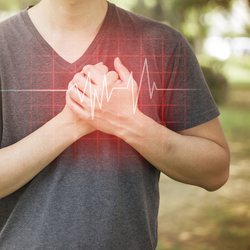
Sudden, unexpected, often deadly. That's the grim truth about cardiac arrest.
More than 350,000 cardiac arrests occur outside of hospitals each year, according to the American Heart Association (AHA). But as alarming as that sounds, people can survive cardiac arrest, provided they receive immediate treatment.
You'll be better able to prevent this life-threatening condition if you understand its causes and risk factors and take steps to control your risks.
And, if you're properly prepared, you may be able to save someone else's life if you witness a cardiac arrest.
Arrest or attack?
First, understand that cardiac arrest isn't the same as a heart attack, though a heart attack can spark cardiac arrest and lead to sudden death.
Think of a heart attack as a plumbing problem. It occurs when coronary heart disease (CHD) clogs the blood vessels to the heart, restricting the blood supply. As a result, heart tissues die.
In contrast, cardiac arrest is an electrical problem.
A healthy heart is controlled by an electrical system that keeps the heart rate and rhythm under control. When that system malfunctions, heartbeats become irregular. For example, the heartbeat may be too fast and chaotic, or it might be too slow and stop. Each of those scenarios can be deadly.
Risk factors for cardiac arrest
According to the AHA and the National Heart, Lung, and Blood Institute, risk factors for cardiac arrest include:
- Previous heart attack. A heart attack causes scar tissue on the heart, which can disrupt electrical signals and cause cardiac arrest.
- A personal or family history of cardiac arrest.
- A thickened heart muscle (usually caused by high blood pressure).
- Stress to the body from extreme physical activity, major blood loss or other cause.
- Drug or alcohol abuse.
- Age. Your risk goes up as you get older.
- Sex. Men are more likely than women to have a cardiac arrest.
Sometimes, cardiac arrest occurs in people who have no obvious risk factors and who look and feel perfectly healthy. But even in these cases, it's likely that there were underlying, though undetected, heart problems.
CHD, for example, can progress slowly and without any outward signs. Some people can even have a symptom-free heart attack, which nevertheless leaves the heart damaged and increases the risk for cardiac arrest.
Control risks, save lives
Taking steps to reduce your risk for CHD will make cardiac arrest less likely. Eating foods low in fat, salt and added sugar; staying physically active; and watching your weight are all great ways to take care of your heart.
Know how to respond
In addition to taking steps to protect your heart, you should also be ready to respond in case you witness a cardiac arrest in someone else. Your immediate action may save a life.
Signs of cardiac arrest include:
- Loss of consciousness.
- No normal breathing.
- No heartbeat.
If you see someone with these symptoms, call 911 and start cardiopulmonary resuscitation (CPR) right away. Push hard and fast in the center of the person's chest until the person starts breathing or moving or help arrives.
If an automated external defibrillator (AED) is available, use it. These devices, now commonly found in many public places such as shopping malls, airports, hotels and sports venues, can be used by people without specific medical training to help others stricken with cardiac arrest.
An AED sends an electric shock to the heart, which can often restore a normal rhythm and prevent sudden death.
If you or someone close to you is at increased risk for cardiac arrest, talk to your doctor. He or she can help you improve heart health and learn what to do should cardiac arrest strike.
Reviewed 10/20/2024
Sources
- American Heart Association. "Causes of Cardiac Arrest" https://www.heart.org/en/health-topics/cardiac-arrest/causes-of-cardiac-arrest.
- American Heart Association. "Emergency Treatment of Cardiac Arrest" https://www.heart.org/en/health-topics/cardiac-arrest/emergency-treatment-of-cardiac-arrest.
- American Heart Association. "Heart Attack and Sudden Cardiac Arrest Differences" https://www.heart.org/en/health-topics/heart-attack/about-heart-attacks/heart-attack-or-sudden-cardiac-arrest-how-are-they-different.
- American Heart Association. "What is Cardiac Arrest?" https://www.heart.org/en/health-topics/cardiac-arrest/about-cardiac-arrest.
- American Heart Assocation CPR & First Aid Emergency Cardiovascular Care. "CPR Facts & Stats" https://cpr.heart.org/en/resources/cpr-facts-and-stats.
- National Heart, Lung, and Blood Institute. "Cardiac arrest: Causes and Risk Factors" https://www.nhlbi.nih.gov/health/cardiac-arrest/causes.
- National Heart, Lung, and Blood Institute. "Cardiac arrest: Life After" https://www.nhlbi.nih.gov/node/93988.
- National Heart, Lung, and Blood Institute. "Cardiac arrest: Symptoms" https://www.nhlbi.nih.gov/health/cardiac-arrest/symptoms.
- National Heart, Lung, and Blood Institute. "Cardiac arrest: Treatment" https://www.nhlbi.nih.gov/health/cardiac-arrest/treatment.
- National Heart, Lung, and Blood Institute. "What Is Cardiac Arrest?" https://www.nhlbi.nih.gov/health/cardiac-arrest.
- MedlinePlus. "Sudden Cardiac Arrest" https://medlineplus.gov/suddencardiacarrest.html.